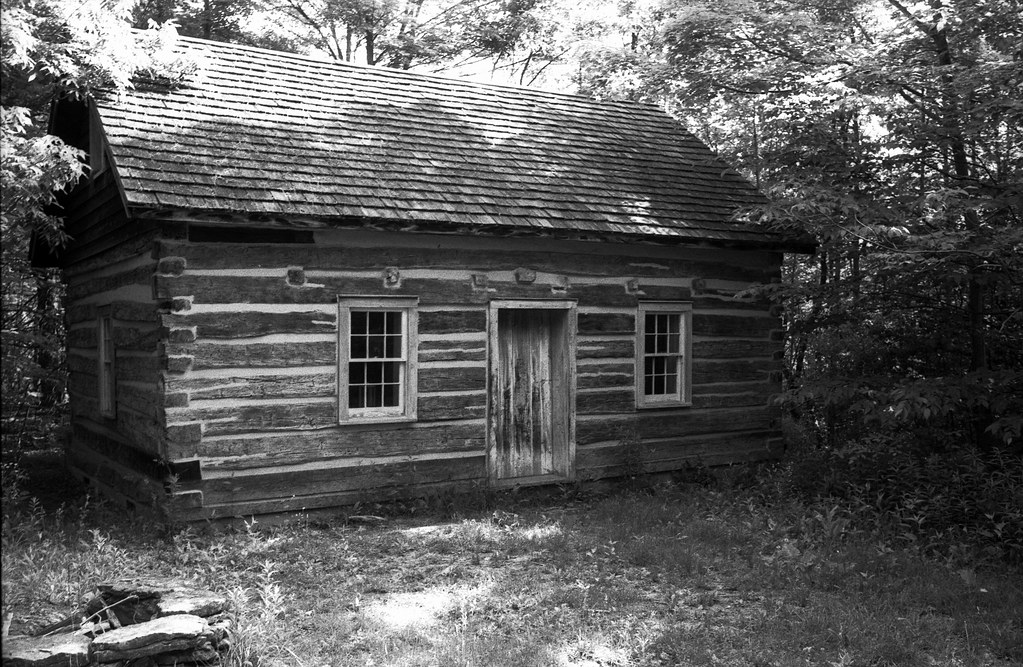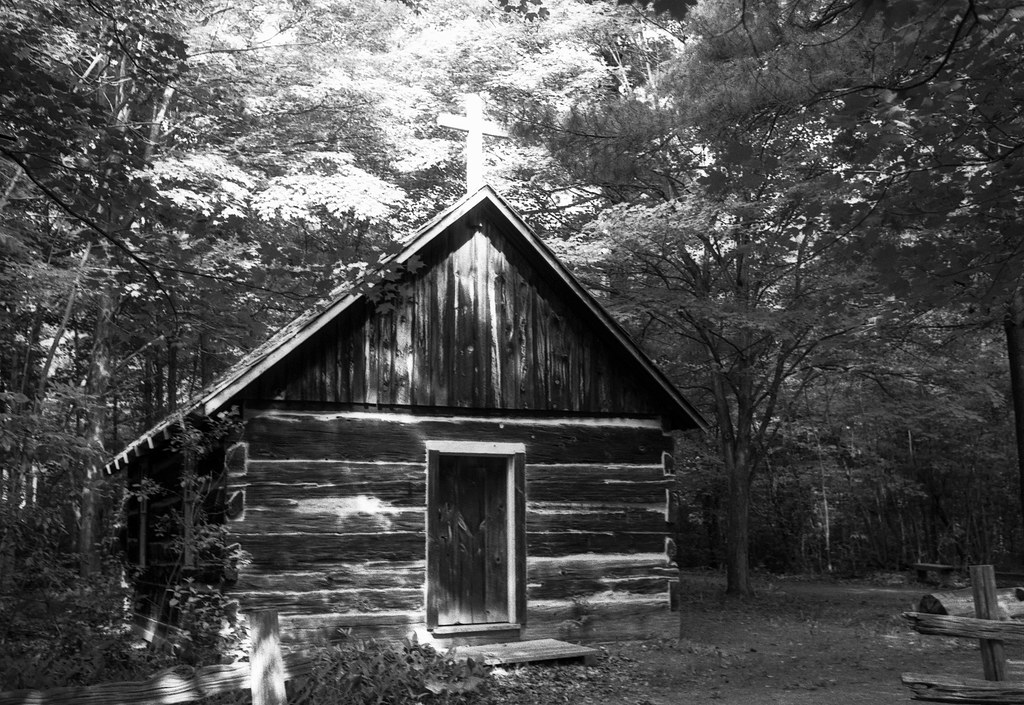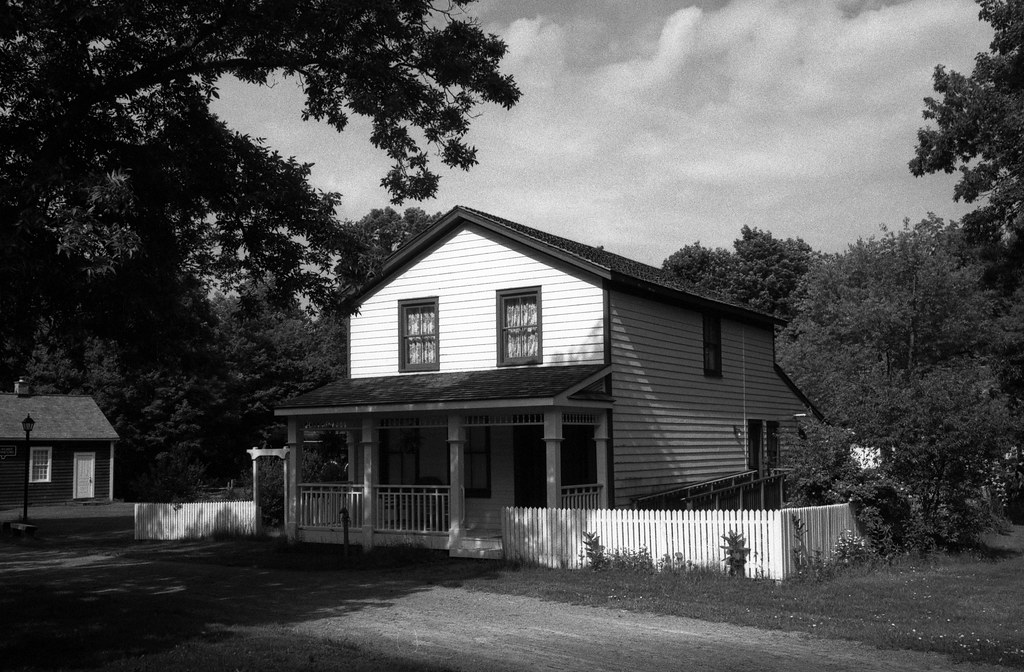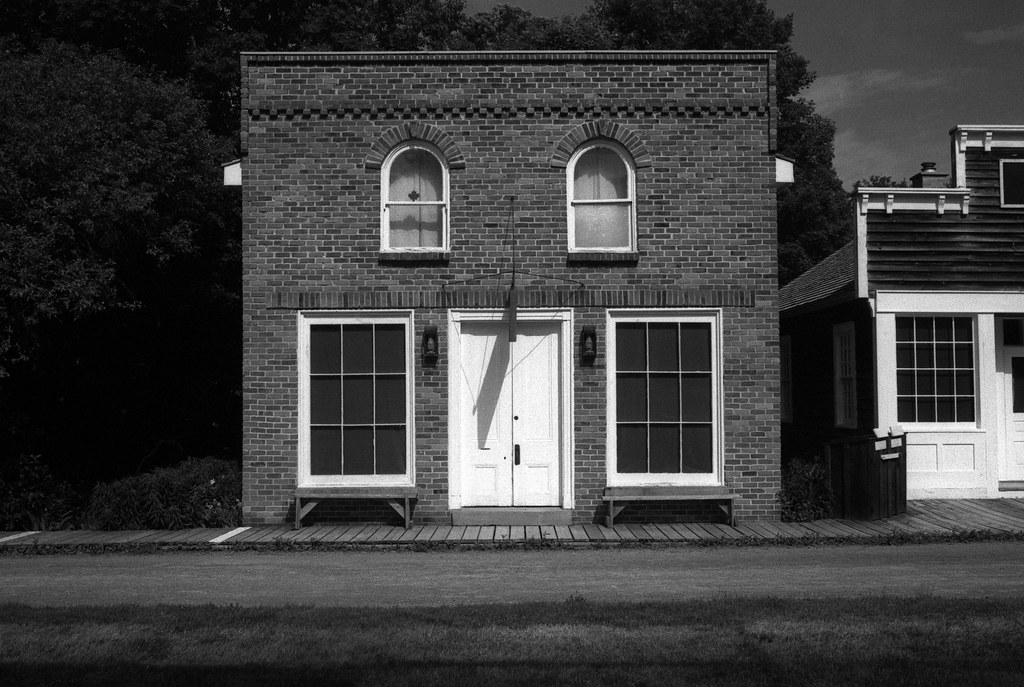When it comes to Living History museums, I have a long enjoyment of these sites. From jumping in Pioneer Puddles at Upper Canada Village to putting on musketry displays before Waterloo’s 200th. One of my favourites is Westfield outside of Hamilton, Ontario. While smaller and quieter, it has some of the oldest buildings from this part of the province! And while the museum aspect is officially closed for the time being, I learned that the site itself remains accessible and without reservations! So I took an early morning visit to avoid any major crowds and got some beautiful morning light.

Nikon FM – AI-S Nikkor 35mm 1:2.8 (Yellow-12) – Fomapan 100 @ ASA-100 – Rollei Supergrain (1+15) 7:30 @ 20C
While every building on the site has its own story, Westfield Heritage Village shares a story of its own! Founded in 1961, the Westfield Pioneer Village Association was the dream given by two high school teachers from Brantford. Glenn Kilmer and Golden Macdonnell purchased a thirty-acre plot of land outside of Rockton, Ontario. Their dream was to save historic buildings from demolition and to create a hands-on education centre for early colonial life in their area of Ontario. Glenn’s wife, Doreen, while not a part of the association, would assist in managing the property. And Glen’s father, owner of Kilmer Lumber in Aylmer, Ontario, joined in helping with the moving and reconstruction of the original set of buildings. Golden would use fieldstones on the site to build a functioning 19th Century forge. The new museum opened on 15 June 1964 as Westfield Pioneer Village, the original twelve buildings staffed by volunteers ranging from older community members to students. Wentworth county purchased the museum in 1968 for 32,700$ with ownership officially transferred on 1 November. The transfer of ownership allowed for Toronto, Hamilton & Buffalo Locomotive 103 in 1977 from the City of Hamilton to sit alongside the Jerseyville Station from the same railroad operator. By 1981, the site changed names to Wentworth Heritage Village as the collection expanded to the point where most buildings were not from the early colonial period. But the village had started to get into financial trouble, forcing it to close its doors in 1984, putting the entire collection at risk. Ideas such as moving the collection elsewhere or transforming the site into a theme park were tossed around. Interest in the village as a filming location started in 1985 when several scenes from an Anne of Green Gables movie were shot at the shuttered museum. In 1990 the site was transferred to the Hamilton Conservation Authority, who began a five-year redevelopment of the site, expanding the property and restoring the thirty buildings and historic locomotive. The new Westfield Heritage Centre opened to the public in 1995 and operated a wide range of programs. And despite the pandemic allowed access to the site without having any buildings open, granting people a chance to enjoy not only the village but the trails across the 840-acre site. Productions are still a part of the site, such as the Red Green Show, Murdoch Mysteries and several smaller productions using the historic site.

Nikon FM – AI-S Nikkor 35mm 1:2.8 (Yellow-12) – Fomapan 100 @ ASA-100 – Rollei Supergrain (1+15) 7:30 @ 20C
Nikon FM – AI-S Nikkor 35mm 1:2.8 (Yellow-12) – Fomapan 100 @ ASA-100 – Rollei Supergrain (1+15) 7:30 @ 20C
It’s hard to choose seven images in a spot that’s a favourite. But like many of these posts, I wanted to give you a good overview of the site. Sadly, I couldn’t get close to one of the site’s crown jewels, Toronto, Hamilton, & Buffalo Locomotive 103 or the TH&B Jerseyville Station, as there was a film crew working there. I had gotten my photos of those locations before they arrived. Westfield has a massive collection of buildings, so first was the iconic covered bridge; while not historical, it is based on many such bridges in Ontario. Next up are some of the oldest buildings on site, which ties this part of the province is with the early colonial history, including the Queen’s Rangers Cabin, Bamberger House, and Log Church. Another historic home, the Gillian House, was home to four generations of the same family. Something we don’t see these days! And finally, two storefronts, the McRobert’s Dry Goods Store and Springfield General Store, which you do see in one episode of the Red Green Show along with the Bamberger House and Bandstand. You can see all my images from the day over on Flickr!

Nikon FM – AI-S Nikkor 35mm 1:2.8 (Yellow-12) – Fomapan 100 @ ASA-100 – Rollei Supergrain (1+15) 7:30 @ 20C
Nikon FM – AI-S Nikkor 35mm 1:2.8 (Yellow-12) – Fomapan 100 @ ASA-100 – Rollei Supergrain (1+15) 7:30 @ 20C
Given the number of other kits I had with me that day, I kept it simple for this week’s roll. I didn’t want to use a 28mm lens, as I would have to get a little too close in some cases and needed, in some cases, a bit more speed on my lens. I ended up going with the old standby for general purpose shooting, the 35mm f/2.8. I went with a yellow-12 filter to cut out the bright light of the day. It did okay; it probably should have gone with something closer to a yellow-15. I shot the film at the box speed of ASA-100 as I was dealing with both direct and covered light. Developing I went with Rollei Supergrain, wanting to finish off some of the partly opened bottles before mixing up new developers I have waiting, like D-23 and Atomal 49.

Nikon FM – AI-S Nikkor 35mm 1:2.8 (Yellow-12) – Fomapan 100 @ ASA-100 – Rollei Supergrain (1+15) 7:30 @ 20C
Nikon FM – AI-S Nikkor 35mm 1:2.8 (Yellow-12) – Fomapan 100 @ ASA-100 – Rollei Supergrain (1+15) 7:30 @ 20C
Doing something a little different next week, we’re embracing the grain for a ‘no theme’ week, but simply a week of carrying a camera around and shooting what I can see.